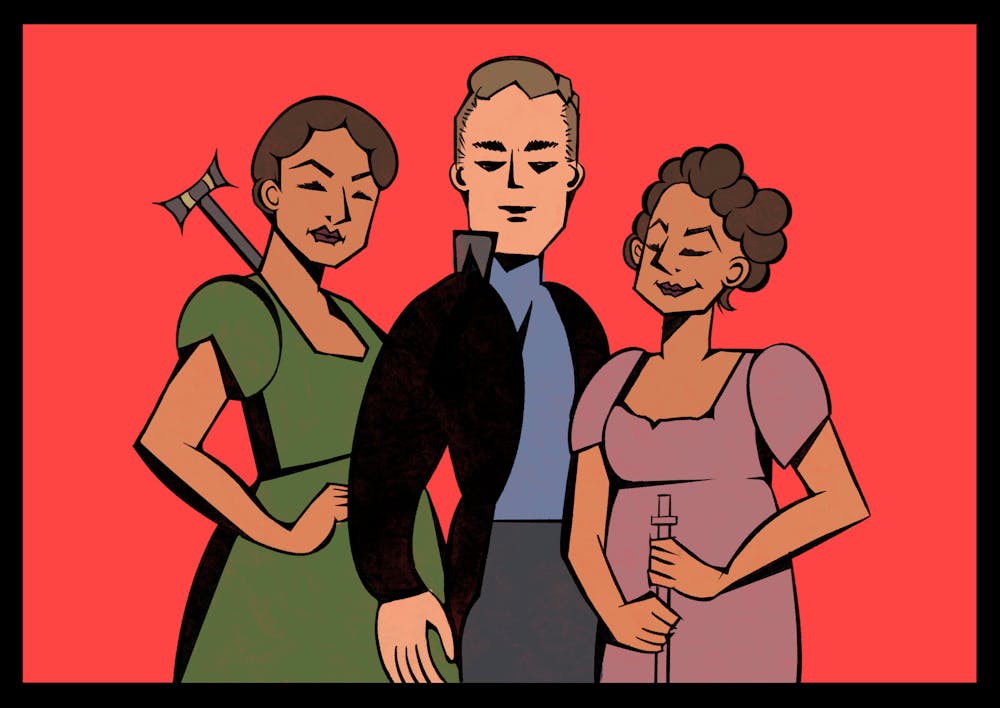This article contains major spoilers for season two of “Bridgerton.”
The first season of “Bridgerton” entranced audiences with its dazzling period costumes and sets, diverse cast and central passionate romance. Main character Daphne Bridgerton, played by Phoebe Dynevor, and reformed rake Simon Basset, played by Regé-Jean Page, charmed with their easy chemistry, charisma and deeply romantic love scenes. Season two of “Bridgerton” rehashes this formula with a new lead couple — Daphne’s brother Anthony and the beautiful Kate Sharma, played by Jonathan Bailey and Simone Ashley, respectively — but falls flat. Serious conflicts replace romantic scenes and high-society gossip, and in the process, “Bridgerton” loses much of its sparkle.
This season's central romantic plotline is a love triangle between Kate, “capital-R Rake” Anthony and Kate’s more “marriageable” younger sister Edwina, played by Charithra Chandran. Kate finds unromantic Anthony to be an unsuitable match for her sister, and subsequently tries to stop a courtship between them by continuously bickering with Anthony and coming between the two.
As Kate and Anthony spar, it becomes obvious that they are deeply attracted to one another. They fall into a slow-burn, enemies-to-lovers relationship, all while Anthony continues courting Edwina.
Unfortunately, “Bridgerton” takes the slow burn too far. The romance between Kate and Anthony moves so slowly that it sucks much of the fun out of the show. First season’s Daphne and Simon developed a lovely friendship early in their season, kissed in episode four and married in episode five. Kate and Anthony, on the other hand, refuse to acknowledge their feelings for one another until Edwina and Anthony’s wedding in episode six.
The wedding scene and its aftermath are hard to watch, as they remind us of how terribly the two leading characters have acted throughout the season. Kate withheld the truth about her feelings knowing that Edwina was in love with Anthony. Meanwhile, Anthony insisted on marrying Edwina — despite having no romantic affection for her — because he was too cowardly to court the woman he truly wanted.
This is certainly a more realistic portrayal of romance and courtship in 19th-century England than the first season. It was perhaps unrealistically convenient for Simon and Daphne to fall in love, find their marriage accepted by their community and settle into a relatively happy relationship after only knowing one another for a short time. Nevertheless, “Bridgerton” is valued as an example of fun escapist television. Save for Anthony and Kate’s brief moments of simmering sexual tension, little about the central romance in season two is enjoyable to watch.
Season two’s more compelling storyline involves Eloise Bridgerton — Daphne’s independent, quick-witted younger sister played by Claudia Jessie — and her best friend, Penelope Featherington, played by Nicola Coughlan. We discovered in season one that Penelope is Lady Whistledown, the town’s gossip pamphlet writer. Eloise spent much of the first season trying to uncover Lady Whistledown’s identity and was ultimately unsuccessful.
Eloise continues her pursuit in season two, and the plotline is ripe with drama. She relies on help from Penelope who, of course, tries to steer her off course. The mystery comes to a head when Lady Whistledown criticizes Eloise’s supposedly radical political beliefs. Eloise grows even more determined to solve the mystery, ultimately leading to disastrous consequences for her friendship with Penelope.
Perhaps the most essential difference between Eloise and Penelope’s storyline and that of Kate, Edwina and Anthony is that Eloise and Penelope are three-dimensional characters. Both women make mistakes, but because they are complex and have understandable, richly-developed reasons for doing so, their story is intriguing rather than simply frustrating.
Because of her status as a Bridgerton, Eloise has a vested interest in finding out the identity of the writer broadcasting her family’s secrets. Cracking the Whistledown mystery also provides a crucial intellectual outlet for a character who is smart but constrained by her status as a Regency-era woman.
Similarly, the foundation of Penelope’s character is the tension between her longing for a place in upper society and her genuine affection for her loved ones. It is compelling to watch Penelope wrestle between the desire to feel like she has an important role in the town through her status as Lady Whistledown while wanting to protect Eloise, her best friend. The Lady Whistledown plot feels much more like the dramatic, gossipy “Bridgerton” viewers fell in love with — we can only wish it had more of a central focus.
“Bridgerton” ends on cliffhangers that hint at a third season. What will happen with Penelope and Eloise? How might the Featheringtons resolve their financial troubles? Hopefully, season three of “Bridgerton” will regain the magic and delight of season one.







